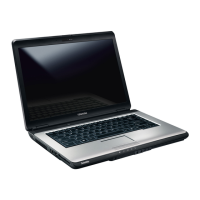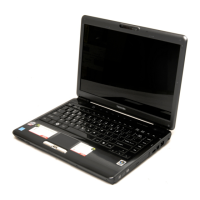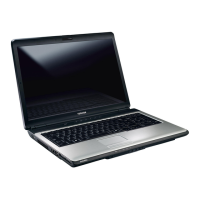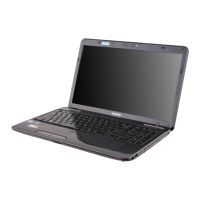
Do you have a question about the Toshiba Satellite L300D and is the answer not in the manual?
| Battery | 6-cell Lithium-Ion |
|---|---|
| LAN | 10/100 Ethernet |
| Processor | AMD Sempron |
| RAM | Up to 4 GB DDR2 |
| Storage | 160 GB HDD |
| Display | 15.4-inch, 1280 x 800 pixels |
| Graphics | ATI Radeon X1250 |
| Operating System | Windows Vista Home Basic |
| Optical Drive | DVD SuperMulti |
| Chipset | AMD M690G |
| Wireless | 802.11b/g |
| Ports | 3 x USB 2.0, VGA, RJ-45, Microphone, Headphone |
| Card Reader | 5-in-1 card reader (SD, MMC, Memory Stick, Memory Stick Pro, xD) |
Details the main features and specifications of the Toshiba Satellite L300D/L305D series notebooks.
Describes the internal hardware components that make up the computer's system unit.
Provides an overview of the chapter, detailing fault diagnosis procedures for Field Replaceable Units (FRUs).
Provides a step-by-step guide to diagnose and identify faulty Field Replaceable Units (FRUs).
Outlines procedures for checking the computer's power supply status via LEDs and connections.
Details troubleshooting steps for the 2.5-inch Hard Disk Drive, including message, partition, format checks.
Introduces diagnostic programs, classifying them into OPTION and DIAGNOSTIC TEST types.
Explains how to use the diagnostic programs, including Quick Test and Customization Test procedures.
Covers tests for CPU functionality, speed, coprocessor, and other system board related diagnostics.
Details tests for BIOS ROM, parity, and various memory patterns to check chip functionality.
Introduces disassembly procedures, safety precautions, and tools needed for component replacement.
Lists critical safety warnings and cautions for handling computer components and performing repairs.
Provides step-by-step instructions for removing and installing the Hard Disk Drive.
Details the procedure for removing and installing the CPU cooling module and fan assembly.
Offers precautions and guidelines for safely handling and installing the LCD module.
Lists all connector pin assignments for various internal and external components.
Illustrates the key layout for different international keyboard variations.
Explains the process of rewriting the system BIOS program when updating the BIOS.












